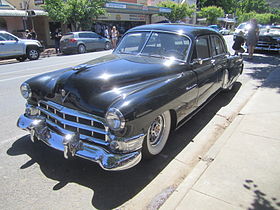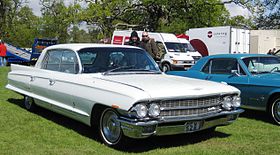Cadillac Sixty Special
| Cadillac Fleetwood Brougham | |
|---|---|

1968 Cadillac Fleetwood Brougham
|
|
| Overview | |
| Manufacturer | Cadillac (General Motors) |
| Production | 1937–1976 1986–1993 |
| Assembly | Detroit Assembly, Detroit, Michigan |
| Body and chassis | |
| Class | Full-size luxury car |
| Chronology | |
| Predecessor | Cadillac Series 70 |
| First generation | |
|---|---|
 |
|
| Overview | |
| Model years | 1938–1941 |
| Assembly | Detroit, Michigan, United States |
| Designer | Bill Mitchell |
| Body and chassis | |
| Body style | 4-door sedan |
| Layout | FR layout |
| Platform | C-body |
| Powertrain | |
| Engine | 346 cu in (5.7 L) Monobloc V8 |
| Transmission | 3-speed selective synchromesh manual 4-speed Hydra-Matic automatic |
| Dimensions | |
| Wheelbase | 1938–40: 127.0 in (3,226 mm) 1941: 126.0 in (3,200 mm) |
| Length | 1938: 207.6 in (5,273 mm) 1939: 214.3 in (5,443 mm) 1940: 216.9 in (5,509 mm) 1941: 217.2 in (5,517 mm) |
| Width | 1938–40: 75.6 in (1,920 mm) 1941: 80.0 in (2,032 mm) |
| Height | 64.5 in (1,638 mm) |
| Curb weight | 4,000–4,500 lb (1,800–2,000 kg) |
| Second generation | |
|---|---|
 |
|
| Overview | |
| Model years | 1942–1947 |
| Assembly | Detroit, Michigan, United States |
| Designer | Bill Mitchell |
| Body and chassis | |
| Body style | 4-door sedan |
| Layout | FR layout |
| Platform | C-body |
| Powertrain | |
| Engine | 346 cu in (5.7 L) Monobloc V8 |
| Transmission | 3-speed selective synchromesh manual 4-speed Hydra-Matic automatic |
| Dimensions | |
| Wheelbase | 133.0 in (3,378 mm) |
| Length | 1942: 224.0 in (5,690 mm) 1946: 224.8 in (5,710 mm) 1947: 223.2 in (5,669 mm) |
| Width | 80.8 in (2,052 mm) |
| Height | 63.1 in (1,603 mm) |
| Curb weight | 4,500–4,600 lb (2,000–2,100 kg) |
| Third generation | |
|---|---|
 |
|
| Overview | |
| Model years | 1948–1949 |
| Assembly | Detroit, Michigan, United States |
| Designer | Bill Mitchell |
| Body and chassis | |
| Body style | 4-door sedan |
| Layout | FR layout |
| Platform | C-body |
| Powertrain | |
| Engine | 346 cu in (5.7 L) Monobloc V8 331 cu in (5.4 L) OHV V8 |
| Transmission | 3-speed selective synchromesh manual 4-speed Hydra-Matic automatic |
| Dimensions | |
| Wheelbase | 133.0 in (3,378 mm) |
| Length | 226.0 in (5,740 mm) |
| Width | 78.2 in (1,986 mm) |
| Height | 62.7 in (1,593 mm) |
| Curb weight | 4,300–4,500 lb (2,000–2,000 kg) |
| Fourth generation | |
|---|---|
 |
|
| Overview | |
| Model years | 1950–1953 |
| Assembly | Detroit, Michigan, United States |
| Designer | Bill Mitchell |
| Body and chassis | |
| Body style | 4-door sedan |
| Layout | FR layout |
| Platform | C-body |
| Powertrain | |
| Engine | 331 cu in (5.4 L) OHV V8 |
| Transmission | 4-speed Hydra-Matic automatic |
| Dimensions | |
| Wheelbase | 130.0 in (3,302 mm) |
| Length | 1950: 224.9 in (5,712 mm) 1951–52: 224.5 in (5,702 mm) 1953: 224.8 in (5,710 mm) |
| Width | 80.1 in (2,035 mm) |
| Height | 62.7 in (1,593 mm) |
| Curb weight | 4,300–4,500 lb (2,000–2,000 kg) |
| Fifth generation | |
|---|---|
 |
|
| Overview | |
| Model years | 1954–1956 |
| Assembly | Detroit, Michigan, United States |
| Designer | Bill Mitchell |
| Body and chassis | |
| Body style | 4-door sedan |
| Layout | FR layout |
| Platform | C-body |
| Powertrain | |
| Engine | 331 cu in (5.4 L) OHV V8 365 cu in (6.0 L) OHV V8 |
| Transmission | 4-speed Hydra-Matic automatic |
| Dimensions | |
| Wheelbase | 133.0 in (3,378 mm) |
| Length | 1954: 227.4 in (5,776 mm) 1955: 227.3 in (5,773 mm) 1956: 225.9 in (5,738 mm) |
| Width | 1954: 79.6 in (2,022 mm) 1955: 79.8 in (2,027 mm) 1956: 80.1 in (2,035 mm) |
| Height | 1954–55: 62.1 in (1,577 mm) 1956: 62.0 in (1,575 mm) |
| Curb weight | 4,700–5,000 lb (2,100–2,300 kg) |
| Sixth generation | |
|---|---|
 |
|
| Overview | |
| Model years | 1957–1958 |
| Assembly | Detroit, Michigan, United States |
| Designer | Bill Mitchell |
| Body and chassis | |
| Body style | 4-door hardtop |
| Layout | FR layout |
| Platform | C-body |
| Powertrain | |
| Engine | 365 cu in (6.0 L) OHV V8 |
| Transmission | 4-speed Hydra-Matic automatic |
| Dimensions | |
| Wheelbase | 133.0 in (3,378 mm) |
| Length | 1957: 224.4 in (5,700 mm) 1958: 225.3 in (5,723 mm) |
| Width | 80.0 in (2,032 mm) |
| Height | 59.1 in (1,501 mm) |
| Curb weight | 4,900–5,100 lb (2,200–2,300 kg) |
| Seventh generation | |
|---|---|
 |
|
| Overview | |
| Model years | 1959–1960 |
| Assembly | Detroit, Michigan, United States |
| Designer | Bill Mitchell |
| Body and chassis | |
| Body style | 4-door hardtop |
| Layout | FR layout |
| Platform | C-body |
| Related |
Cadillac DeVille Cadillac Eldorado Cadillac Series 62 Buick Electra Oldsmobile 98 |
| Powertrain | |
| Engine | 390 cu in (6.4 L) OHV V8 |
| Transmission | 4-speed Hydra-Matic automatic |
| Dimensions | |
| Wheelbase | 130.0 in (3,302 mm) |
| Length | 225.0 in (5,715 mm) |
| Width | 1959: 81.1 in (2,060 mm) 1960: 79.9 in (2,029 mm) |
| Height | 56.2 in (1,427 mm) |
| Curb weight | 5,100 lb (2,300 kg) |
| Eighth generation | |
|---|---|
 |
|
| Overview | |
| Model years | 1961–1964 |
| Assembly | Detroit, Michigan, United States |
| Designer | Bill Mitchell |
| Body and chassis | |
| Body style | 4-door hardtop |
| Layout | FR layout |
| Platform | C-body |
| Related |
Cadillac DeVille Cadillac Eldorado Cadillac Series 62 Buick Electra Oldsmobile 98 |
| Powertrain | |
| Engine | 390 cu in (6.4 L) OHV V8 429 cu in (7.0 L) OHV V8 |
| Transmission | 4-speed Hydra-Matic automatic 3-speed TH-400, automatic |
| Dimensions | |
| Wheelbase | 129.5 in (3,289 mm) |
| Length | 1961–62: 222.0 in (5,639 mm) 1963: 223.0 in (5,664 mm) 1964: 223.5 in (5,677 mm) |
| Width | 1961: 79.8 in (2,027 mm) 1962: 79.9 in (2,029 mm) 1963: 79.7 in (2,024 mm) 1964: 79.5 in (2,019 mm) |
| Height | 1961–62: 56.3 in (1,430 mm) 1963–64: 56.6 in (1,438 mm) |
| Curb weight | 4,900 lb (2,200 kg) |
| Ninth generation | |
|---|---|
 |
|
| Overview | |
| Model years | 1965–1970 |
| Assembly | Detroit, Michigan, United States |
| Designer | Bill Mitchell |
| Body and chassis | |
| Body style | 4-door sedan |
| Layout | FR layout |
| Platform | C-body |
| Related |
Cadillac Calais Cadillac DeVille Cadillac Eldorado Buick Electra Oldsmobile 98 |
| Powertrain | |
| Engine | 429 cu in (7.0 L) OHV V8 472 cu in (7.7 L) OHV V8 |
| Transmission | 3-speed TH-400, automatic |
| Dimensions | |
| Wheelbase | 133.0 in (3,378 mm) |
| Length | 1965–67: 227.5 in (5,778 mm) 1968: 228.2 in (5,796 mm) 1969–70: 228.5 in (5,804 mm) |
| Width | 1965–68: 79.9 in (2,029 mm) 1969–70: 79.8 in (2,027 mm) |
| Height | 1965–68: 56.6 in (1,438 mm) 1969–70: 56.8 in (1,443 mm) |
| Curb weight | 4,800–5,000 lb (2,200–2,300 kg) |
The Cadillac Sixty Special name has been used by Cadillac to denote a special model since the 1938 Harley Earl-Bill Mitchell-designed Series 60 derivative. The Sixty Special name would soon be synonymous for some of Cadillac's most luxurious vehicles. This exclusivity was reflected in the introduction of the exclusive Fleetwood Sixty Special Brougham d'Elegance in 1973, and the Fleetwood Sixty Special Brougham Talisman in 1974.
For 1938, the Harley Earl-Bill Mitchell designed Sixty Special was added between Cadillac's lowest-priced line of cars, the "Series 60", and the "Senior" large-bodied Cadillacs. It replaced the model "70" (short-base Series 70). Although all first-generation 60 Specials were built at the Fleetwood Plant, the 60 Special was marketed as a Fisher Body car in 1938 and 1939.
The new four-door sedan, designed to look like a convertible sedan, showcased trend-setting features including a completely integrated, coupe-like trunk (which launched "three-box" sedan styling); no running boards (which all makes soon followed); two-piece, convertible-style doors (Bill Mitchell called the '38 60 Special "the first hardtop"); a "four-window" canopy with more glass area than any Cadillac before; a steeply-raked windshield and four front-hinged doors. Contrary to what was then the trend in luxury automobiles, the new Sixty Special was intended as an owner-driven car, rather than a chauffeur-driven one.
It was built on a 127.0-inch (3,230 mm) wheelbase - 3-inch (76 mm) longer than the standard Series 60 cars. The new Sixty Special utilized a unique "X" frame underneath, which allowed the 4,170 lb (1,890 kg). car to sit within its frame. This not only gave the new Cadillac the stiffest chassis on the market, but it was also 3 inches lower than other Cadillacs - with no sacrifice in headroom. The disappearance of running boards along the side and its lack of belt-line trim made the sleek car appear even lower. More important, it allowed shoulder and hip room to increase by over 5 inches without an increase in overall width. When combined with the brand-new column-mounted shift lever, the cars offered true six passenger comfort. The Sixty Special was powered by Cadillac's standard 130 hp (97 kW), 346 cu in (5.67 L) V8 engine.
In its debut year, 3,703 Sixty Specials were delivered, at a base cost of $2,090 each - it was a success in every measure. The new Sixty Special outsold every other Cadillac model in its first year accounting for 39% of all Cadillacs sold. In 1938, aside from the standard 4-door sedan, two prototype models were built on the Sixty Special body - two very dashing four-door convertibles (one owned by GM executive, Larry Fisher, which was demolished by Harley Earl in a traffic accident and one sent to Europe, which was later recalled and consumed by GM Engineering in structural tests in preparation for the 1940 "Torpedo" bodies), plus one Sixty-Special coupe (driven personally for two years by GM President, Bill Knudsen).
...
Wikipedia
